Two Hydrothermal Events at the Shuiyindong Carlin-Type Gold Deposit in Southwestern China: Insight from Sm–Nd Dating of Fluorite and Calcite
Abstract
1. Introduction
2. Geological Setting
3. Sampling and Analytical Methods
4. Results
5. Discussion
6. Conclusions
Author Contributions
Funding
Acknowledgments
Conflicts of Interest
References
- Yan, J.; Hu, R.Z.; Liu, S.; Lin, Y.T.; Zhang, J.C.; Fu, S.L. NanoSIMS element mapping and sulfur isotope analysis of Au-bearing pyrite from Lannigou Carlin-type Au deposit in SW China: New insights into the origin and evolution of Au-bearing fluids. Ore Geol. Rev. 2018, 92, 29–41. [Google Scholar] [CrossRef]
- Xie, Z.J.; Xia, Y.; Cline, J.S.; Koenig, A.; Wei, D.T.; Tan, Q.P.; Wang, Z.P. Are There Carlin-Type Gold Deposits in China? A Comparison of the Guizhou, China, Deposits with Nevada, USA, Deposits. In Diversity of Carlin-Style Gold Deposits, Reviews in Economic Geology; Muntean, J.L., Ed.; Society of Economic Geologists: Littleton, CO, USA, 2018; Volume 20, pp. 187–233. [Google Scholar]
- Hu, R.Z.; Fu, S.L.; Huang, Y.; Zhou, M.F.; Fu, S.H.; Zhao, C.H.; Wang, Y.J.; Bi, X.W.; Xiao, J.F. The giant South China Mesozoic low-temperature metallogenic domain: Reviews and a new geodynamic model. J. Asian Earth Sci. 2017, 137, 9–34. [Google Scholar] [CrossRef]
- Xie, Z.J.; Xia, Y.; Cline, J.S.; Pribil, M.J.; Koenig, A.; Tan, Q.P.; Wei, D.T.; Wang, Z.P.; Yan, J. Magmatic Origin for Sediment-Hosted Au Deposits, Guizhou Province, China: In Situ Chemistry and Sulfur Isotope Composition of Pyrites, Shuiyindong and Jinfeng Deposits. Econ. Geol. 2018, 113, 1627–1652. [Google Scholar]
- Su, W.C.; Dong, W.D.; Zhang, X.C.; Shen, N.P.; Hu, R.Z.; Hofstra, A.H.; Cheng, L.Z.; Xia, Y.; Yang, K.Y. Carlin-Type Gold Deposits in the Dian-Qian-Gui “Golden Triangle” of Southwest China. In Diversity of Carlin-Style Gold Deposits, Reviews in Economic Geology; Muntean, J.L., Ed.; Society of Economic Geologists: Littleton, CO, USA, 2018; Volume 20, pp. 157–185. [Google Scholar]
- 1:2,500,000 Chinese Geological Map, The National Geological Archives of China. Available online: http://geodata.ngac.cn/Document/Map.aspx?MapId=EC7E1A7A7CF81954E0430100007F182E (accessed on 12 April 2019).
- Chen, M.H.; Huang, Q.W.; Hu, Y.; Chen, Z.Y.; Zhang, W. Genetic type of Phyllosilicate (Micas) and its Ar-Ar dating in Lannigou gold deposit, Guizhou Province, China. Acta Mineral. Sin. 2009, 29, 353–362, (In Chinese with English Abstract). [Google Scholar]
- Chen, M.H.; Mao, J.W.; Li, C.; Zhang, Z.Q.; Dang, Y. Re–Os isochron ages for arsenopyrite from Carlin-like gold deposits in the Yunnan–Guizhou–Guangxi “golden triangle”, southwestern China. Ore Geol. Rev. 2015, 64, 316–327. [Google Scholar]
- Pi, Q.H.; Hu, R.Z.; Xiong, B.; Li, Q.L.; Zhong, R. In situ SIMS U-Pb dating of hydrothermal rutile: Reliable age for the Zhesang Carlin-type gold deposit in the golden triangle region, SW China. Miner. Depos. 2017, 52, 1179–1190. [Google Scholar] [CrossRef]
- Su, W.C.; Hu, R.Z.; Xia, B.; Xia, Y.; Liu, Y.P. Calcite Sm-Nd isochron age of the Shuiyindong Carlin-type gold deposit, Guizhou, China. Chem. Geol. 2009, 258, 269–274. [Google Scholar] [CrossRef]
- Wang, Z.P. Genesis and Dynamic Mechanism of the Epithermal Ore Deposits, SW Guizhou, China—A Case Study of Gold and Antimony Deposits. Ph.D. Thesis, University of Chinese Academy of Sciences, Beijing, China, 2013. (In Chinese with English Abstract). [Google Scholar]
- Chen, M.H.; Bagas, L.; Liao, X.; Zhang, Z.Q.; Li, Q.L. Hydrothermal apatite SIMS ThPb dating: Constraints on the timing of low-temperature hydrothermal Au deposits in Nibao, SW China. Lithos 2019, 324–325, 418–428. [Google Scholar]
- Peng, J.T.; Hu, R.Z.; Burnard, P.G. Samarium-neodymium isotope systematics of hydrothermal calcites from the Xikuangshan antimony deposit (Hunan, China): The potential of calcite as a geochronometer. Chem. Geol. 2003, 200, 129–136. [Google Scholar] [CrossRef]
- Jiang, S.Y.; Slack, J.F.; Palmer, M.R. Sm-Nd dating of the giant Sullivan Pb-Zn-Ag deposit, British Columbia. Geology 2000, 28, 751–754. [Google Scholar]
- Anglin, C.D.; Jonasson, I.R.; Franklin, J.M. Sm-Nd dating of scheelite and tourmaline; implications for the genesis of Archean gold deposits, Val d’Or, Canada. Econ. Geol. 1996, 91, 1372–1382. [Google Scholar] [CrossRef]
- Chesley, J.T.; Halliday, A.N.; Kyser, T.K.; Spry, P.G. Direct dating of mississippi valley-type mineralization; use of Sm-Nd in fluorite. Econ. Geol. 1994, 89, 1192–1199. [Google Scholar] [CrossRef]
- Chesley, J.T.; Halliday, A.N.; Scrivener, R.C. Samarium-neodymium direct dating of fluorite mineralization. Science 1991, 252, 949–951. [Google Scholar] [CrossRef] [PubMed]
- Zou, Z.C.; Hu, R.Z.; Bi, X.W.; Wu, L.Y.; Feng, C.X.; Tang, Y.Y. Absolute and relative dating of Cu and Pb-Zn mineralization in the Baiyangping area, Yunnan Province, SW China: Sm-Nd geochronology of calcite. Geochem. J. 2015, 49, 103–112. [Google Scholar] [CrossRef][Green Version]
- Wang, J.S.; Wen, H.J.; Fan, H.F.; Zhu, J.J. Sm-Nd geochronology, REE geochemistry and C and O isotope characteristics of calcites and stibnites from the Banian antimony deposit, Guizhou Province, China. Geochem. J. 2012, 46, 393–407. [Google Scholar] [CrossRef]
- Uysal, I.T.; Zhao, J.X.; Golding, S.D.; Lawrence, M.G.; Glikson, M.; Collerson, K.D. Sm-Nd dating and rare-earth element tracing of calcite: Implications for fluid-flow events in the Bowen Basin, Australia. Chem. Geol. 2007, 238, 63–71. [Google Scholar] [CrossRef]
- Roberts, S.; Palmer, M.R.; Waller, L. Sm-Nd and REE characteristics of tourmaline and scheelite from the Bjorkdal gold deposit, northern Sweden: Evidence of an intrusion-related gold deposit? Econ. Geol. 2006, 101, 1415–1425. [Google Scholar] [CrossRef]
- Bell, K.; Anglin, C.; Franklin, J. Sm-Nd and Rb-Sr isotope systematics of scheelites: Possible implications for the age and genesis of vein-hosted gold deposits. Geology 1989, 17, 500–504. [Google Scholar] [CrossRef]
- Chernyshev, I.V.; Golubev, V.N.; Aleshin, A.P.; Larionova, Y.O.; Gol’tsman, Y.V. Fluorite as an Sm-Nd geochronometer of hydrothermal processes: Dating of mineralization hosted in the Strel’tsovka uranium ore field, eastern Baikal region. Geol. Ore Depos. 2016, 58, 447–455. [Google Scholar] [CrossRef]
- Xu, W.G.; Fan, H.R.; Hu, F.F.; Santosh, M.; Yang, K.F.; Lan, T.G.; Wen, B.J. Geochronology of the Guilaizhuang gold deposit, Luxi Block, eastern North China Craton: Constraints from zircon U-Pb and fluorite-calcite Sm-Nd dating. Ore Geol. Rev. 2015, 65, 390–399. [Google Scholar] [CrossRef]
- Munoz, M.; Premo, W.; Courjault-Rade, P. Sm-Nd dating of fluorite from the worldclass Montroc fluorite deposit, southern Massif Central, France. Miner. Depos. 2005, 39, 970–975. [Google Scholar] [CrossRef]
- Tan, Q.P.; Xia, Y.; Wang, X.Q.; Xie, Z.J.; Wei, D.T. Carbon-oxygen isotopes and rare earth elements as an exploration vector for Carlin-type gold deposits: A case study of the Shuiyindong gold deposit, Guizhou Province, SW China. J. Asian Earth Sci. 2017, 148, 1–12. [Google Scholar] [CrossRef]
- Liu, J.Z.; Yang, C.F.; Wang, Z.P.; Wang, D.F.; Qi, L.S.; Li, J.H.; Hu, C.W.; Xu, L.Y. Geological research of Shuiyindong gold deposit in Zhenfeng County, Guizhou Province. Geol. Surv. China 2017, 4, 32–41, (In Chinese with English Abstract). [Google Scholar]
- Tan, Q.P.; Xia, Y.; Xie, Z.J.; Yan, J. Migration paths and precipitation mechanisms of ore-forming fluids at the Shuiyindong Carlin-type gold deposit, Guizhou, China. Ore Geol. Rev. 2015, 69, 140–156. [Google Scholar] [CrossRef]
- Zhu, J.J.; Hu, R.Z.; Richards, J.P.; Bi, X.-W.; Stern, R.; Lu, G. No genetic link between Late Cretaceous felsic dikes and Carlin-type Au deposits in the Youjiang basin, Southwest China. Ore Geol. Rev. 2017, 84, 328–337. [Google Scholar] [CrossRef]
- Su, W.C.; Xia, B.; Zhang, H.T.; Zhang, X.C.; Hu, R.Z. Visible gold in arsenian pyrite at the Shuiyindong Carlin-type gold deposit, Guizhou, China: Implications for the environment and processes of ore formation. Ore Geol. Rev. 2008, 33, 667–679. [Google Scholar] [CrossRef]
- Tan, Q.P.; Xia, Y.; Xie, Z.J.; Yan, J.; Wei, D.T. S, C, O, H, and Pb isotopic studies for the Shuiyindong Carlin-type gold deposit, Southwest Guizhou, China: Constraints for ore genesis. Chin. J. Geochem. 2015, 34, 525–539. [Google Scholar] [CrossRef]
- Tan, Q.P.; Xia, Y.; Wang, X.Q.; Xie, Z.J.; Wei, D.T. Tectonic model and tectonic-geochemistry characteristics of the Huijiabao gold orefield, SW Guizhou Province. Geotecton. Metallog. 2017, 41, 291–304, (In Chinese with English Abstract). [Google Scholar]
- Cline, J.S. Nevada’s Carlin-Type Gold Deposits: What We’ ve Learned During the Past 10 to 15 Years. In Diversity of Carlin-Style Gold Deposits, Reviews in Economic Geology; Muntean, J.L., Ed.; Society of Economic Geologists: Littleton, CO, USA, 2018; Volume 20, pp. 7–37. [Google Scholar]
- Li, X.X.; Zhu, X.Q.; Gu, Y.T.; Ling, K.Y.; Sheng, X.Y.; He, L. Mineralogy and Geochemistry Characteristics and Genetic Implications for Stratabound Carlin-Type Gold Deposits in Southwest Guizhou, China. J. Nanosci. Nanotechnol. 2017, 17, 6307–6317. [Google Scholar] [CrossRef]
- Zhang, J.R.; Wen, H.J.; Qiu, Y.Z.; Zhang, Y.X.; Li, C. Ages of sediment-hosted Himalayan Pb-Zn-Cu-Ag polymetallic deposits in the Lanping basin, China: Re-Os geochronology of molybdenite and Sm-Nd dating of calcite. J. Asian Earth Sci. 2013, 73, 284–295. [Google Scholar] [CrossRef]
- Ludwig, R.K. ISOPLOT: A plotting and regression program for radiogenic isotope data (Version 2.9). U.S. Geol. Surv. Open-File Rep. 1996, 91, 445–447. [Google Scholar]
- Su, W.C.; Heinrich, C.A.; Pettke, T.; Zhang, X.C.; Hu, R.Z.; Xia, B. Sediment-hosted gold deposits in Guizhou, China: Products of wall-rock sulfidation by deep crustal fluids. Econ. Geol. 2009, 104, 73–93. [Google Scholar] [CrossRef]
- Su, W.C.; Zhang, H.T.; Hu, R.Z.; Ge, X.; Xia, B.; Chen, Y.Y.; Zhu, C. Mineralogy and geochemistry of gold-bearing arsenian pyrite from the Shuiyindong Carlin-type gold deposit, Guizhou, China: Implications for gold depositional processes. Miner. Depos. 2012, 47, 653–662. [Google Scholar] [CrossRef]
- Peng, J.T.; Hu, R.Z.; Jiang, G.H. Samarium-Neodymium isotope system of fluorites from the Qinglong antimony deposit, Guizhou Province: Constrains on the mineralizing age and ore-forming materials’ sources. Acta Petrol. Sin. 2003, 19, 785–791, (In Chinese with English Abstract). [Google Scholar]
- Chen, J.F.; Jahn, B.M. Crustal evolution of southeastern China: Nd and Sr isotopic evidence. Tectonophysics 1998, 284, 101–133. [Google Scholar] [CrossRef]
- Chung, S.-L.; Jahn, B.-M. Plume-lithosphere interaction in generation of the Emeishan flood basalts at the Permian-Triassic boundary. Geology 1995, 23, 889–892. [Google Scholar] [CrossRef]
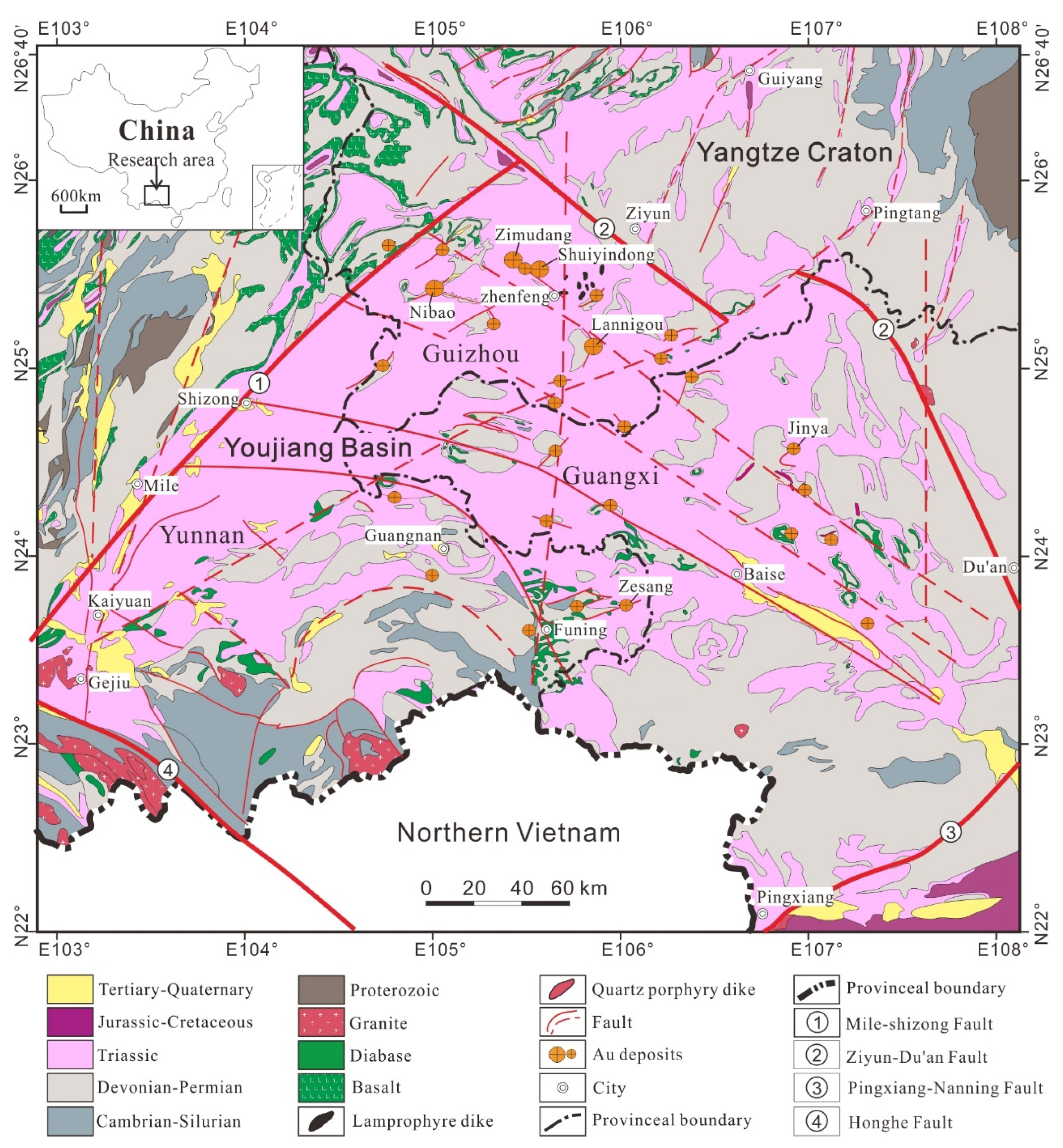
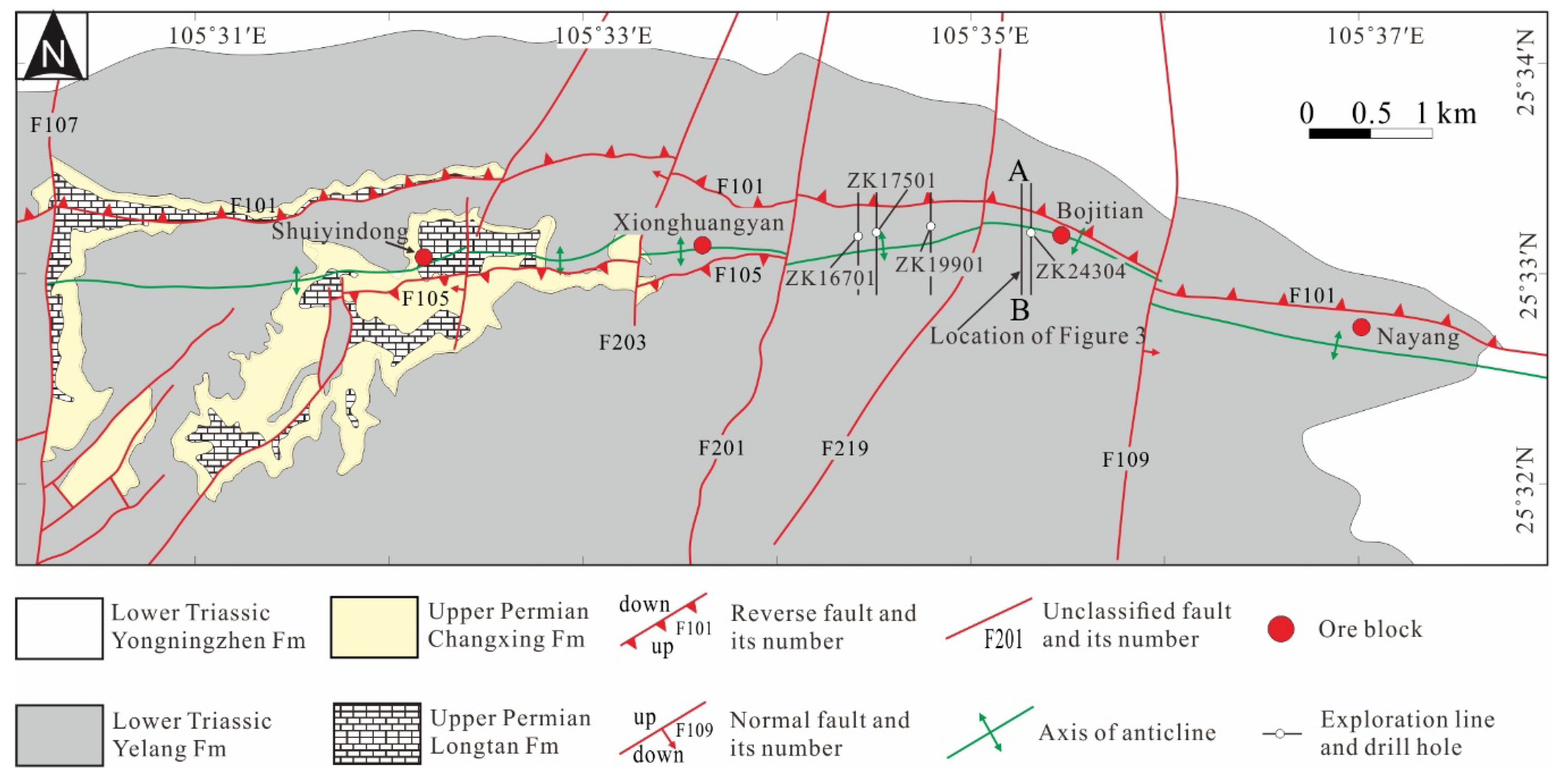
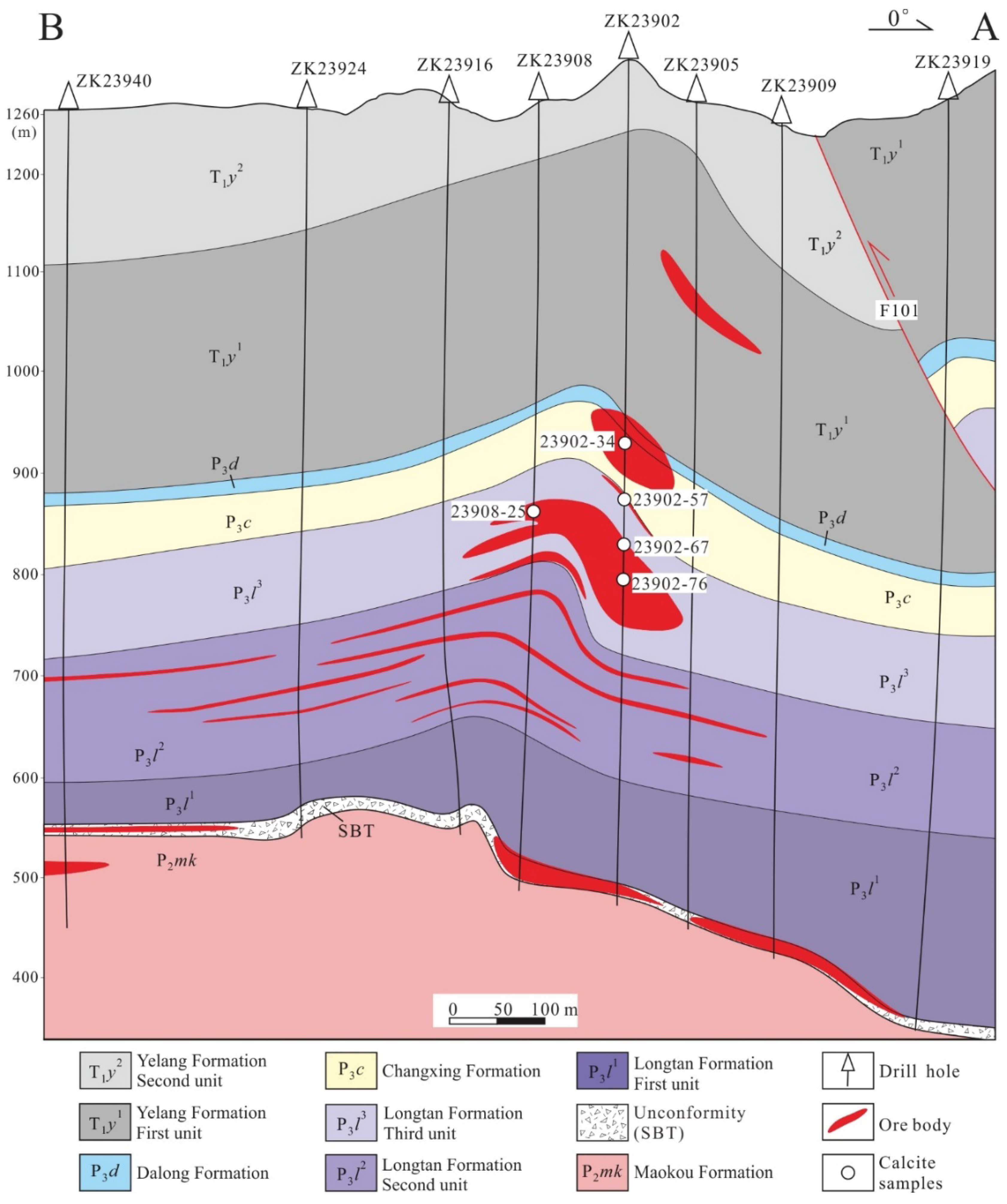

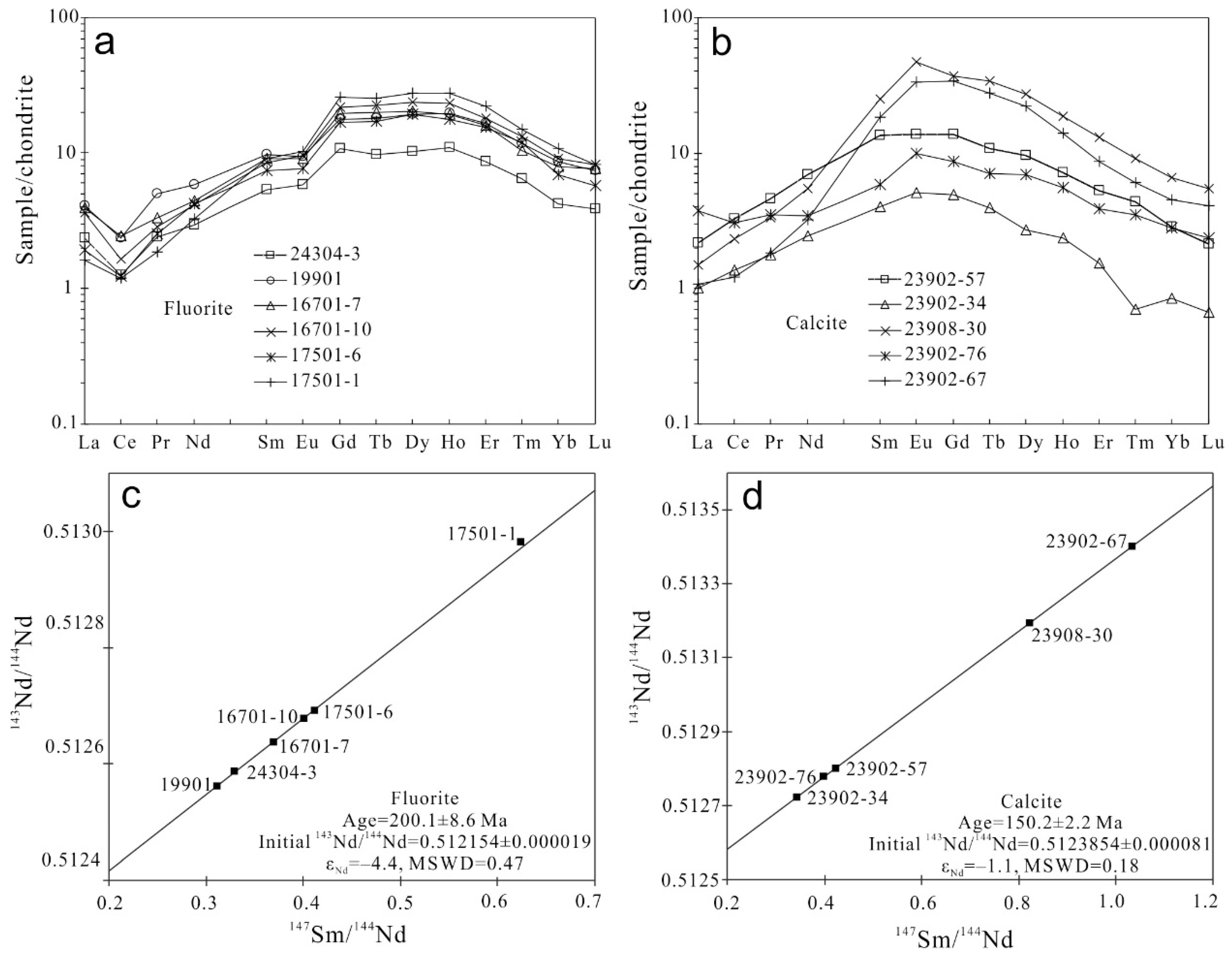

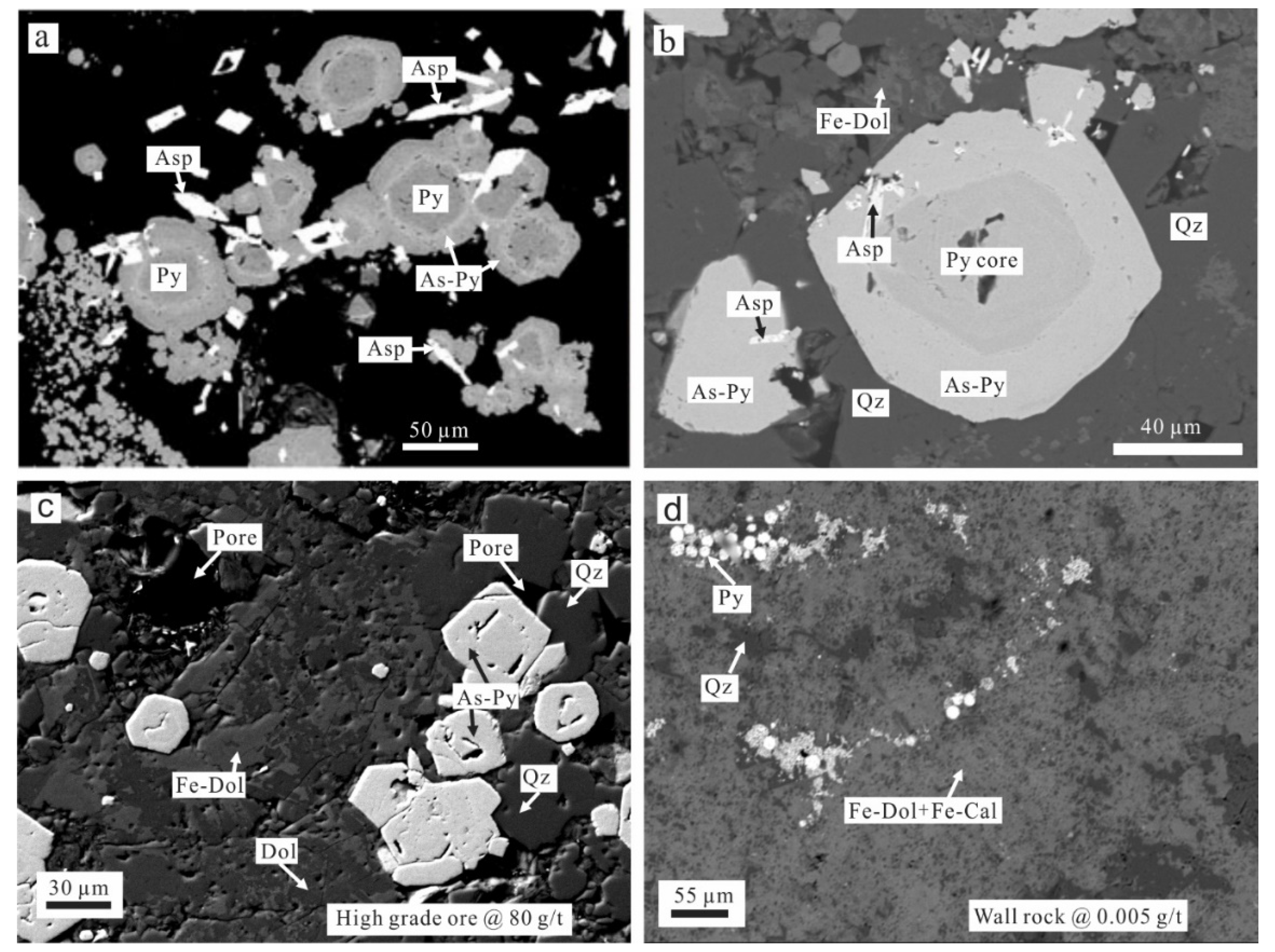
| Sample Number | Minerals | Locality | La | Ce | Pr | Nd | Sm | Eu | Gd | Tb | Dy | Ho | Er | Tm | Yb | Lu | ΣREE | δEu |
|---|---|---|---|---|---|---|---|---|---|---|---|---|---|---|---|---|---|---|
| 16701-7 | Fluorite | ZK16701, 615 m | 0.938 | 1.48 | 0.317 | 2.06 | 1.40 | 0.523 | 4.02 | 0.745 | 5.17 | 1.10 | 2.64 | 0.266 | 1.34 | 0.196 | 22.2 | 0.67 |
| 16701-10 | Fluorite | ZK16701, 627 m | 0.850 | 0.999 | 0.269 | 1.94 | 1.29 | 0.552 | 4.43 | 0.841 | 6.06 | 1.32 | 2.97 | 0.335 | 1.54 | 0.209 | 23.6 | 0.71 |
| 17501-1 | Fluorite | ZK17501, 600 m | 0.386 | 0.723 | 0.175 | 1.52 | 1.40 | 0.593 | 5.26 | 0.946 | 6.95 | 1.56 | 3.65 | 0.380 | 1.84 | 0.210 | 25.6 | 0.67 |
| 17501-6 | Fluorite | ZK17501, 605 m | 0.451 | 0.750 | 0.239 | 1.97 | 1.13 | 0.442 | 3.48 | 0.635 | 4.87 | 0.99 | 2.57 | 0.306 | 1.18 | 0.146 | 19.2 | 0.68 |
| 19901 | Fluorite | ZK19901, 675 m | 0.959 | 1.43 | 0.476 | 2.71 | 1.48 | 0.543 | 3.64 | 0.671 | 4.87 | 1.11 | 2.74 | 0.298 | 1.47 | 0.187 | 22.6 | 0.71 |
| 24304-3 | Fluorite | ZK24204, 747 m | 0.559 | 0.768 | 0.226 | 1.38 | 0.815 | 0.340 | 2.20 | 0.365 | 2.62 | 0.62 | 1.43 | 0.166 | 0.714 | 0.099 | 12.3 | 0.78 |
| 23902-34 | Calcite | ZK23902, 376 m | 0.239 | 0.838 | 0.169 | 1.14 | 0.609 | 0.296 | 1.01 | 0.148 | 0.69 | 0.13 | 0.25 | 0.018 | 0.144 | 0.017 | 5.71 | 1.15 |
| 23902-57 | Calcite | ZK23902, 441 m | 0.511 | 2.000 | 0.439 | 3.24 | 2.06 | 0.794 | 2.81 | 0.401 | 2.44 | 0.40 | 0.88 | 0.112 | 0.484 | 0.054 | 16.6 | 1.01 |
| 23902-67 | Calcite | ZK23902, 487 m | 0.254 | 0.745 | 0.174 | 1.50 | 2.83 | 1.94 | 7.02 | 1.03 | 5.66 | 0.79 | 1.43 | 0.153 | 0.773 | 0.104 | 24.4 | 1.33 |
| 23902-76 | Calcite | ZK23902, 522 m | 0.892 | 1.88 | 0.330 | 1.60 | 0.894 | 0.572 | 1.77 | 0.263 | 1.76 | 0.31 | 0.64 | 0.090 | 0.480 | 0.060 | 11.5 | 1.39 |
| 23908-30 | Calcite | ZK23908, 427 m | 0.354 | 1.43 | 0.316 | 2.56 | 3.85 | 2.72 | 7.59 | 1.26 | 6.88 | 1.05 | 2.16 | 0.234 | 1.12 | 0.138 | 31.7 | 1.54 |
| Sample Number | Occurrence | Sm (μg/g) | Nd (μg/g) | Sm/Nd | 147Sm/144Nd | 143Nd/144Nd <2σ> | εNd |
|---|---|---|---|---|---|---|---|
| 16701-7 | Fl | 1.4365 | 2.3481 | 0.61 | 0.3699 | 0.512637 ± 0.000006 | −4.4 |
| 16701-10 | Fl | 1.1948 | 1.7974 | 0.66 | 0.4019 | 0.512678 ± 0.000013 | −4.4 |
| 17501-1 | Fl + Cal | 1.3179 | 1.2764 | 1.03 | 0.6242 | 0.512981 ± 0.000023 | −4.2 |
| 17501-6 | Fl + Cal | 1.2285 | 1.8001 | 0.68 | 0.4126 | 0.512692 ± 0.000009 | −4.4 |
| 19901 | Fl + Cal + Qz | 1.6196 | 3.1428 | 0.52 | 0.3115 | 0.512561 ± 0.000005 | −4.4 |
| 24304-3 | Fl | 0.8801 | 1.6124 | 0.55 | 0.3300 | 0.512587 ± 0.000003 | −4.4 |
| 23902-34 | Cal | 0.6734 | 1.1878 | 0.57 | 0.3427 | 0.512721 ± 0.000010 | −1.1 |
| 23902-57 | Cal + Rlg + Orp | 2.1858 | 3.1230 | 0.70 | 0.4231 | 0.512798 ± 0.000011 | −1.2 |
| 23902-67 | Cal + Rlg + Orp | 2.7132 | 1.5875 | 1.71 | 1.0332 | 0.513401 ± 0.000008 | −1.1 |
| 23902-76 | Cal + Rlg + Orp | 1.0964 | 1.6630 | 0.66 | 0.3986 | 0.512778 ± 0.000004 | −1.1 |
| 23908-30 | Cal + Rlg + Orp | 3.9756 | 2.9210 | 1.36 | 0.8228 | 0.513194 ± 0.000017 | −1.1 |
© 2019 by the authors. Licensee MDPI, Basel, Switzerland. This article is an open access article distributed under the terms and conditions of the Creative Commons Attribution (CC BY) license (http://creativecommons.org/licenses/by/4.0/).
Share and Cite
Tan, Q.; Xia, Y.; Xie, Z.; Wang, Z.; Wei, D.; Zhao, Y.; Yan, J.; Li, S. Two Hydrothermal Events at the Shuiyindong Carlin-Type Gold Deposit in Southwestern China: Insight from Sm–Nd Dating of Fluorite and Calcite. Minerals 2019, 9, 230. https://doi.org/10.3390/min9040230
Tan Q, Xia Y, Xie Z, Wang Z, Wei D, Zhao Y, Yan J, Li S. Two Hydrothermal Events at the Shuiyindong Carlin-Type Gold Deposit in Southwestern China: Insight from Sm–Nd Dating of Fluorite and Calcite. Minerals. 2019; 9(4):230. https://doi.org/10.3390/min9040230
Chicago/Turabian StyleTan, Qinping, Yong Xia, Zhuojun Xie, Zepeng Wang, Dongtian Wei, Yimeng Zhao, Jun Yan, and Songtao Li. 2019. "Two Hydrothermal Events at the Shuiyindong Carlin-Type Gold Deposit in Southwestern China: Insight from Sm–Nd Dating of Fluorite and Calcite" Minerals 9, no. 4: 230. https://doi.org/10.3390/min9040230
APA StyleTan, Q., Xia, Y., Xie, Z., Wang, Z., Wei, D., Zhao, Y., Yan, J., & Li, S. (2019). Two Hydrothermal Events at the Shuiyindong Carlin-Type Gold Deposit in Southwestern China: Insight from Sm–Nd Dating of Fluorite and Calcite. Minerals, 9(4), 230. https://doi.org/10.3390/min9040230






